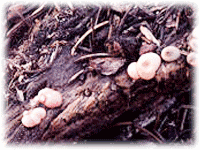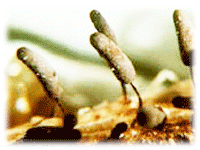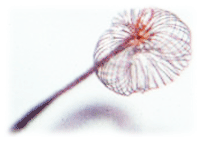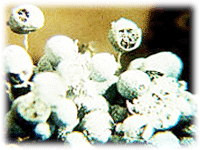
More Articles

Real people affected by Stachybotrys - field observations:
A family of four lived in a rented house in the San Fernando Valley. The two children, both toddlers, had lived in the house their entire lives. They had also lived with chronic respiratory problems and other health symptoms from the beginning.
When I arrived on the scene there were water stains and suspected mold growth in several locations on the ceiling of the family room. A section of the drywall ceiling was partially detached and sagging right over the top of an exercise machine. There was black mold growth on the upper side of the ceiling in this area. I was told that when it rained water dripped down from the ceiling in the vicinity of the exercise machine. I immediately recommended that the family room be isolated from the remainder of the house and the children not be allowed inside the room under any circumstances. The black mold was verified as Stachybotrys chartarum. By the time I received the laboratory reports and completed my report, the parents reported that the children’s conditions had improved. I attribute their improvement to their reduced exposure to this toxic mold. The family moved out of the house before the removal and remediation of the mold could be accomplished.

For approximately seven years a family had lived in a luxury condominium located in an upscale gated community. It was reported to me that a pinhole plumbing leak in the wall behind the kitchen sink had apparently been present for a very long time, possibly since the time the family had occupied the residence. When the leak was finally discovered, the entire back walls of the kitchen cabinets were covered with black mold. Cookware, pots, and pans had been stored in those cabinets. Most of the infected walls had already been removed by the time I conducted my investigation. I did manage to find some small pieces of drywall that had been left after the wall was removed. Using these pieces of drywall, Stachybotrys chartarum was detected by the laboratory. The chilling part of this story is that their beautiful six-year-old daughter had been ill virtually all her life with digestive and respiratory maladies. She even had to have the majority of her small intestines removed. Although she was reportedly examined by a number of doctors, none were able to discover the source of her illnesses. Storing cookware in cabinets infested with Stachybotrys can result in toxic mold spores contaminating the food cooked in them. It has been suggested that the potency of mycotoxins by ingesting toxic mold spores may not be as devastating as exposure by inhalation, but what about in combination? Young children with underdeveloped immune systems, however, would be particularly susceptible to virtually any toxic substance. Could this child have been a victim of the potent toxins produced by Stachybotrys?
We were conducting an indoor air quality inspection of a hospital. Part of the inspection included essentially random checks of patient rooms’ HVAC units. Each room is air conditioned by use of its own fan/coil air-conditioning unit located above the ceiling. The coolant used was chilled water provided by a chiller located in another part of the building complex. We began our inspection of one room by opening the hatch in the restroom that provided access to the fan/coil unit located above the ceiling.

Almost immediately upon opening the hatch, I began coughing. I first thought, “maybe I haven’t been taking very good care of myself lately and am getting a cold.” I very rarely get sick, but my frequent exposure to molds could make me susceptible to illnesses notwithstanding the various supplements I take to bolster my immune system. I continued to cough until I put my head above the ceiling and coughed even more as I spotted heavy growth of black mold on the upper side of the ceiling. Sections of the cold water pipes were not insulated which resulted in heavy condensation on the surface of the pipes that had dripped down onto the drywall ceiling. Continuous wetting of the drywall paper fostered the growth of Stachybotrys. We found a number of other rooms in similar condition. Once the mold growth was discovered, these rooms were of course closed, isolated and proper remediation done. It appears that at times a hospital is not a good place to be if you are ill.

Real People affected by Aspergillus - field observations
An elderly gentleman lived in an exclusive condominium complex. He was suffering from a respiratory condition that his doctors could not diagnose. One of the most worrisome of the symptoms was coughing up blood. My company was brought in to investigate his indoor environment as a last resort.
In our questioning, we learned that he enjoyed sleeping with the temperature very low. He would usually set the thermostat to 60 degrees Fahrenheit or below even if the temperature outside were over 100, which is not so unusual for LA in the summer. The low temperature relative to outside tended to produce a lot of moisture inside the air conditioning unit due to condensation on the cooling coils. When we took samples from the interior of the air conditioning unit we found a growth of Penicillium/Aspergillus type mold. Although Penicillium and Aspergillus spores are relatively indistinguishable when viewed under a microscope, we suspected due to the symptoms that at least some of the growth was likely Aspergillus. The immune system tends to become weaker with age rendering a person more susceptible to infections with molds and other opportunistic pathogens. For this reason, we thought it's important to suggest that the respiratory symptoms could be due to an infection with Aspergillus. One of the symptoms of Aspergillus infections is pulmonary bleeding and coughing up blood. This information was provided to the man’s physician and he was successfully treated for Aspergillosis.
Corrective actions were, of course, taken with his air conditioning unit and other factors related to his indoor environment.
A young girl of about sixteen lived with her family in a suburban house of about 2500 square feet. She began suffering from severe headaches, nausea, and vertigo. I recognized that this could be a condition that might be fostered or aggravated by exposure to molds. I suspected that this condition could be a result of a mold infection or a toxic reaction to mold exposure.
In my inspection and testing of the house, I found some water stains on the ceiling of the girl’s bedroom that were not seen elsewhere in the house. An air sample revealed slightly elevated levels of Penicillium/Aspergillus spores in her room. Her bedroom floor was covered with a fairly plush carpet. She also had a relatively large collection of stuffed animals and dolls. My suspicion was that mold growth due to rain leaks resulted in mold spores becoming airborne. In addition to exposure to mold spores in the ambient air, whatever is in the air eventually falls out. Carpets and fleecy materials accumulate dust, which can be laden with mold spores if there is or has been an indoor mold growth source. Spores can become airborne again by occupant activity such as walking across a carpet of handling stuffed animals. My recommendations included removal of the water stained portions of the ceiling and walls under specific protocols as well as environmental deep cleaning of the room. Such cleaning includes a thorough vacuuming of all surfaces (floor, walls, and contents) using HEPA filtered vacuums. This would be followed by a wipe down of hard dust collecting surfaces using damp cloths. Additionally, the carpet would need to be cleaned using a hot water deep extraction method ensuring the carpet and any padding is completely dried within 24 hours. The stuffed animals were to be HEPA vacuumed and shampooed to remove accumulated mold spores. Getting sufficient fresh air into the room was also part of the recommendations.
Since molds can be harmful whether they are dead or alive, the only logical and realistic choice in dealing with mold growth is to remove the growth or the material the mold is growing on. Following the removal it is also necessary to eliminate excessive mold spores “fallout” in the vicinity, furnishings, carpets, etc. that could continue to cause health problems even after the growth has been removed.
The steps required for acceptable removal and remediation of mold growth can be found at the U.S. EPA website, www.epa.gov/iaq/iaqinfo.html.
The roll of fresh air:
The introduction of sufficient volume outside air into an indoor environment will help to alleviate if not eliminate many indoor air quality problems. The principle to consider is “the dose makes the poison.” Dilution of many contaminants with outside air reduces the dose and thereby renders the toxins or allergens less potent. This principle applies to mold as well as other contaminants. Outside air must, of course, be drawn from a location that is not polluted.
Since introducing outside air via the filtered ventilation system can also result in positive pressurization of the interior of the building, such pressurization can help to isolate the occupied space from possible outdoor contamination as well as from basements, attics, crawl spaces, and wall interiors. Opening windows is often helpful, but sometimes impractical. A better solution is bringing in outside air through the ventilation system with efficient filtration to serve the dual purpose of dilution and pressurization.
Everyone knows … that people get ill more often during the winter because of the cold. Certainly, if one gets chilled to the degree that body temperature is lowered, that person may be more subject to invasion by pathogens. But consider this. During the winter most people spend more time indoors thereby getting much less fresh air. Exposure to indoor contaminants including molds as well as pathogens brought into space by other occupants or visitors is increased due to little outside air being introduced to dilute the contaminants. Introducing sufficient outside air might well reduce the phenomenon of colds and other contagious illnesses being passed from one person to another in a house or an office.
What can you do about it?
There are no panaceas. The best defense against mold and other indoor pollution is to have a basic knowledge of the sources and causes of indoor contamination and the proper steps to take in order to eliminate the contamination and to prevent its return.
Here are some pointers:
- If someone in your residence or workplace is suffering from respiratory problems, particularly if they feel better when away from the location for a period of time, suspect mold growth in the vicinity or insufficient outside air.
- If there is visible mold growth or water stains on ceilings or walls, you must discover the water or moisture source and eliminate it. Any mold growth must then be removed per existing protocols.
- If you smell moldy, damp or earthy odors suspect mold growth in the vicinity or inside the ventilation system.
- Clean up any leaks or floods without delay. The major motto regarding mold has to be “Control moisture.”
- If floods are not responded to quickly, the “usual” methods of drying out portions of a building can actually spread contamination. Mold will begin growing due to a flood within 48 to 72 hours. Beyond that time, if you try to dry an area out with fans, you will likely be spreading contamination by blowing mold spores into other areas.
- Get plenty of non-polluted outside air into the building either by opening windows or by having outside air introduced via the ventilation system.
- If you suspect that mold or other indoor contaminants are adversely affecting you, educate yourself in the proper actions to take. Consult with your physician or someone specializing in environmental illnesses. If you cannot easily resolve the problem yourself, contact a professional who can conduct inspection and testing of the area you are concerned with and will make recommendations of specific actions to take to reduce or eliminate your problem.
- Remember that even in this relatively young field of indoor air quality, common sense goes a long way. If a professional cannot answer questions to your satisfaction, the answers are probably wrong. Go with a professional who can answer your questions and whose answers make sense to you.
- Any holistic approach to health would be lacking without taking the environment into consideration.
Recycling is a good thing from a general environmental viewpoint. Recycling, when we are talking about our homes or our bodies, is not so desirable. If we don’t learn the proper actions to take, we could be recycled sooner than we expect...






